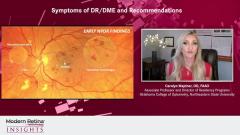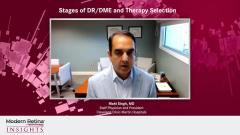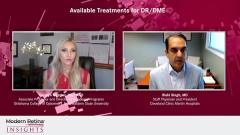
Reducing Treatment Burden of DR/DME
Diabetic retinal disease experts discuss different approaches that can reduce the treatment burden while maintaining good visual outcomes during diabetic retinopathy and diabetic macular edema (DR/DME) therapy.
Episodes in this series

Carolyn Majcher, OD, FAAO: Multiple studies have reported low adherence to monthly anti-VEGF [vascular endothelial growth factor] among patients with diabetic retinopathy or diabetic macular edema [DME]. What are some approaches or therapies that can reduce the treatment burden while maintaining good visual outcomes?
Rishi Singh, MD: First and foremost, I think it’s important for the retina specialists to sit down with the patient and explain the treatment paradigm of what we’re doing. Too many times it’s not discussed. It’s one of those situations where the patient comes in, you’re having a busy day, you talk to them about the treatment, and they go home. Then they come back the next month and the month after that and [they ask], how long am I going to be coming back here, and why didn’t you explain to me in the first place? I think that that is certainly a gap in our patients’ knowledge with regard to the fact that there’s ongoing care and maintenance with all of these injections regardless of how long they endure them for. Because right now we’re at a place where we need to really see the other parts of the treatment approach and see what the other outcomes are for these patients as well.
Thankfully, there are a lot of drugs that are helping to extend the intervals of treatments. I can tell you that in current practice, with current FDA-approved drugs, the most you’re going to get is 2 months, sometimes 3 months, if you’re lucky, [and that’s based] upon many, many randomized clinical trials. Right now we have the first FDA-approved drug, faricimab, which came out recently. This is a combined ang-2 [angiopoietin-2] and anti-VEGF drug modified to an Fc [fragment crystallizable region] fragment. This drug has been shown to be very beneficial and have a good duration. Up to 75% to 78% of patients are able to go [to a dose of] Q [every] 12 weeks or beyond at 2 years after getting the drug. It’s really quite impressive, with less frequent dosing with faricimab compared to controlled drugs in this category.
Another investigational product that I’m excited about is 8 mg aflibercept, which is an improvement from the 2 mg that’s offered today. That should have a much better drying effect. The studies that have been done so far have showed a greater durability in AMD [age‐related macular degeneration] populations. We’re eagerly waiting to hear more of the DME results to see if it was just as good as what we saw in AMD. Apparently, that’s the next phase of drugs going out in that area and that [has the] ability to treat these patients with higher doses and potentially different mechanism of actions. For example, in the faricimab trial, that’s an anti-angiopoietin-2 and an anti-VEGF bound in a single Fc fragment. Again, this technology has allowed us to create fusion proteins, it has allowed us to create high-dose drugs. It’s going to be interesting to see how we can achieve better adherence with the drugs over time.
Carolyn Majcher, OD, FAAO: I’m really excited about that. You mentioned patient education, and I’d like to piggyback off of that a little bit because [as] optometric physicians, we spend a lot of time with our patients and educate them. [It] is absolutely critical when trying to detect the earliest diabetic retinopathy and macular edema possible that they need to understand that you can have vision-threatening complications when the vision is still good. Symptoms do not indicate the presence or absence of any sort of disease. Also, this is a chronic condition. Diabetic retinopathy, like you mentioned, requires continuous care and treatments that may need to be repeated for life. Any sort of injection or PRP [panretinal photocoagulation] laser therapy isn’t a cure. Sometimes patients have that misconception. I think it’s really important that we educate patients on that.
TRANSCRIPT EDITED FOR CLARITY
Newsletter
Keep your retina practice on the forefront—subscribe for expert analysis and emerging trends in retinal disease management.





















































